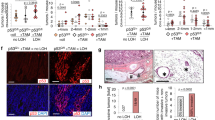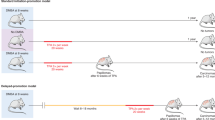Abstract
The p53 gene is frequently mutated in cancers and it is vital for cell cycle control, homeostasis and carcinogenesis. We describe a novel p53 mutational spectrum, different to those generally observed in human and murine tumors. Our study shows a high prevalence of nonsense mutations in the p53 N terminus of 2-acetylaminofluorene (2-AAF)-induced urinary bladder tumors. These nonsense mutations forced downstream translation initiation at codon 41 of Trp53, resulting in the aberrant expression of the p53 isoform ΔN-p53 (or p44). We propose a novel mechanism for the origination and the selection for this isoform. We show that chemical exposure can act as a novel cause of selection for this truncated protein. In addition, our data suggest that the occurrence of ΔN-p53 accounts, at least in mice, for a cancer phenotype. We also show that gene expression profiles of embryonic stem (ES) cells carrying the ΔN-p53 isoform in a p53-null background are divergent from p53 knockout ES cells, and therefore postulate that ΔN-p53 itself has functional transcriptional properties.
This is a preview of subscription content, access via your institution
Access options
Subscribe to this journal
Receive 50 print issues and online access
$259.00 per year
only $5.18 per issue
Buy this article
- Purchase on Springer Link
- Instant access to full article PDF
Prices may be subject to local taxes which are calculated during checkout




Similar content being viewed by others
References
Bruins W, Zwart E, Attardi LD, Iwakuma T, Hoogervorst EM, Beems RB et al. (2004). Increased sensitivity to UV radiation in mice with a p53 point mutation at Ser389. Mol Cell Biol 24: 8884–8894.
Candeias MM, Powell DJ, Roubalova E, Apcher S, Bourougaa K, Vojtesek B et al. (2006). Expression of p53 and p53/47 are controlled by alternative mechanisms of messenger RNA translation initiation. Oncogene 25: 6936–6947.
Courtois S, Verhaegh G, North S, Luciani MG, Lassus P, Hibner U et al. (2002). DeltaN-p53, a natural isoform of p53 lacking the first transactivation domain, counteracts growth suppression by wild-type p53. Oncogene 21: 6722–6728.
de Leeuw WC, Rauwerda H, Jonker MJ, Breit TM . (2008). Salvaging Affymetrix probes after probe-level re-annotation. BMC Res Notes 1: 66.
de Vries A, Flores ER, Miranda B, Hsieh HM, van Oostrom CT, Sage J et al. (2002). Targeted point mutations of p53 lead to dominant-negative inhibition of wild-type p53 function. Proc Natl Acad Sci USA 99: 2948–2953.
Dennis Jr G, Sherman BT, Hosack DA, Yang J, Gao W, Lane HC et al. (2003). DAVID: Database for Annotation, Visualization, and Integrated Discovery. Genome Biol 4: 3.
Denys H, Braems G, Lambein K, Pauwels P, Hendrix A, De Boeck A et al. (2009). The extracellular matrix regulates cancer progression and therapy response: implications for prognosis and treatment. Curr Pharm Des 15: 1373–1384.
Ghosh A, Stewart D, Matlashewski G . (2004). Regulation of human p53 activity and cell localization by alternative splicing. Mol Cell Biol 24: 7987–7997.
Grover R, Candeias MM, Fahraeus R, Das S . (2009). p53 and little brother p53/47: linking IRES activities with protein functions. Oncogene 28: 2766–2772.
Hailfinger S, Jaworski M, Marx-Stoelting P, Wanke I, Schwarz M . (2007). Regulation of P53 stability in p53 mutated human and mouse hepatoma cells. Int J Cancer 120: 1459–1464.
Heinlein C, Krepulat F, Lohler J, Speidel D, Deppert W, Tolstonog GV . (2008). Mutant p53(R270H) gain of function phenotype in a mouse model for oncogene-induced mammary carcinogenesis. Int J Cancer 122: 1701–1709.
Hollstein M, Sidransky D, Vogelstein B, Harris CC . (1991). p53 mutations in human cancers. Science 253: 49–53.
Hoogervorst EM, Bruins W, Zwart E, van Oostrom CT, van den Aardweg GJ, Beems RB et al. (2005a). Lack of p53 Ser389 phosphorylation predisposes mice to develop 2-acetylaminofluorene-induced bladder tumors but not ionizing radiation-induced lymphomas. Cancer Res 65: 3610–3616.
Hoogervorst EM, van Oostrom CT, Beems RB, van Benthem J, Gielis S, Vermeulen JP et al. (2004). p53 heterozygosity results in an increased 2-acetylaminofluorene-induced urinary bladder but not liver tumor response in DNA repair-deficient Xpa mice. Cancer Res 64: 5118–5126.
Hoogervorst EM, van Steeg H, de Vries A . (2005b). Nucleotide excision repair- and p53-deficient mouse models in cancer research. Mutat Res 574: 3–21.
Hosack DA, Dennis Jr G, Sherman BT, Lane HC, Lempicki RA . (2003). Identifying biological themes within lists of genes with EASE. Genome Biol 4: R70.
Irizarry RA, Bolstad BM, Collin F, Cope LM, Hobbs B, Speed TP . (2003). Summaries of Affymetrix GeneChip probe level data. Nucleic Acids Res 31: e15.
Iwakuma T, Lozano G . (2007). Crippling p53 activities via knock-in mutations in mouse models. Oncogene 26: 2177–2184.
Jacks T, Remington L, Williams BO, Schmitt EM, Halachmi S, Bronson RT et al. (1994). Tumor spectrum analysis in p53-mutant mice. Curr Biol 4: 1–7.
Kozak M . (1984). Compilation and analysis of sequences upstream from the translational start site in eukaryotic mRNAs. Nucleic Acids Res 12: 857–872.
Levine AJ . (1997). p53, the cellular gatekeeper for growth and division. Cell 88: 323–331.
Levine AJ, Momand J, Finlay CA . (1991). The p53 tumour suppressor gene. Nature 351: 453–456.
Lim LY, Vidnovic N, Ellisen LW, Leong CO . (2009). Mutant p53 mediates survival of breast cancer cells. Br J Cancer 101: 1606–1612.
Lozano G . (2007). The oncogenic roles of p53 mutants in mouse models. Curr Opin Genet Dev 17: 66–70.
Maier B, Gluba W, Bernier B, Turner T, Mohammad K, Guise T et al. (2004). Modulation of mammalian life span by the short isoform of p53. Genes Dev 18: 306–319.
Marcel V, Hainaut P . (2009). p53 isoforms—a conspiracy to kidnap p53 tumor suppressor activity? Cell Mol Life Sci 66: 391–406.
Matheu A, Maraver A, Serrano M . (2008). The Arf/p53 pathway in cancer and aging. Cancer Res 68: 6031–6034.
Ohki R, Kawase T, Ohta T, Ichikawa H, Taya Y . (2007). Dissecting functional roles of p53 N-terminal transactivation domains by microarray expression analysis. Cancer Sci 98: 189–200.
Olive KP, Tuveson DA, Ruhe ZC, Yin B, Willis NA, Bronson RT et al. (2004). Mutant p53 gain of function in two mouse models of Li–Fraumeni syndrome. Cell 119: 847–860.
Powell DJ, Hrstka R, Candeias M, Bourougaa K, Vojtesek B, Fahraeus R . (2008). Stress-dependent changes in the properties of p53 complexes by the alternative translation product p53/47. Cell Cycle 7: 950–959.
Pupa SM, Menard S, Forti S, Tagliabue E . (2002). New insights into the role of extracellular matrix during tumor onset and progression. J Cell Physiol 192: 259–267.
Ray PS, Grover R, Das S . (2006a). Two internal ribosome entry sites mediate the translation of p53 isoforms. EMBO Rep 7: 404–410.
Ray PS, Grover R, Das S . (2006b). Two internal ribosome entry sites mediate the translation of p53 isoforms. EMBO Rep 7: 404–410.
Ross JA, Leavitt SA . (1998). Induction of mutations by 2-acetylaminofluorene in lacI transgenic B6C3F1 mouse liver. Mutagenesis 13: 173–179.
Sigal A, Rotter V . (2000). Oncogenic mutations of the p53 tumor suppressor: the demons of the guardian of the genome. Cancer Res 60: 6788–6793.
Soussi T . (2007). p53 alterations in human cancer: more questions than answers. Oncogene 26: 2145–2156.
Strano S, Dell'Orso S, Di Agostino S, Fontemaggi G, Sacchi A, Blandino G . (2007). Mutant p53: an oncogenic transcription factor. Oncogene 26: 2212–2219.
Vousden KH, Bos JL, Marshall CJ, Phillips DH . (1986). Mutations activating human c-Ha-ras1 protooncogene (HRAS1) induced by chemical carcinogens and depurination. Proc Natl Acad Sci USA 83: 1222–1226.
Wijnhoven SW, Zwart E, Speksnijder EN, Beems RB, Olive KP, Tuveson DA et al. (2005). Mice expressing a mammary gland-specific R270H mutation in the p53 tumor suppressor gene mimic human breast cancer development. Cancer Res 65: 8166–8173.
Xu Y . (2008). Induction of genetic instability by gain-of-function p53 p53 cancer mutants. Oncogene 27: 3501–3507.
Yin Y, Stephen CW, Luciani MG, Fahraeus R . (2002). p53 Stability and activity is regulated by Mdm2-mediated induction of alternative p53 translation products. Nat Cell Biol 4: 462–467.
Acknowledgements
We thank the Animal Facilities of the Netherlands Vaccine Institute (NVI) for their skillful (bio)technical support. The work presented here was in part financially supported by NIH/NIEHS (Comparative Mouse Genomics Centers Consortium) Grant 1UO1 ES11044.
Author information
Authors and Affiliations
Corresponding author
Ethics declarations
Competing interests
The authors declare no conflict of interest.
Additional information
Supplementary Information accompanies the paper on the Oncogene website
Rights and permissions
About this article
Cite this article
Melis, J., Hoogervorst, E., van Oostrom, C. et al. Genotoxic exposure: novel cause of selection for a functional ΔN-p53 isoform. Oncogene 30, 1764–1772 (2011). https://doi.org/10.1038/onc.2010.552
Received:
Revised:
Accepted:
Published:
Issue Date:
DOI: https://doi.org/10.1038/onc.2010.552



